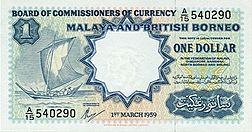Malaya and British Borneo dollar facts for kids
Quick facts for kids Malaya and British Borneo dollar |
|||
|---|---|---|---|
| Ringgit (Malay) رڠڬيت (Jawi) |
|||
|
|||
| User(s) | Malaya, Singapore, Brunei, North Borneo and Sarawak | ||
| Subunit | |||
| 1⁄100 | cent | ||
| Symbol | $ | ||
| Coins | 1, 5, 10, 20, 50 cents | ||
| Banknotes | 1, 5, 10, 50, 100, 1000, 10000 dollars | ||
The Malaya and British Borneo dollar was a special type of money used in several countries from 1953 to 1967. It was called ringgit in Malay and رڠڬيت in Jawi. This currency was used in Malaya, Singapore, Sarawak, North Borneo, Brunei, and even some parts of Indonesia called the Riau archipelago.
This dollar replaced older currencies like the Malayan dollar and Sarawak dollar. A special group called the Board of Commissioners of Currency, Malaya and British Borneo, was in charge of printing and issuing this money. Even after Malaya became independent in 1957 and Malaysia was formed in 1963, this currency was still used. Singapore also used it after gaining independence in 1965.
However, in 1967, these countries decided to start using their own money. The Malaya and British Borneo dollar was still accepted as legal money until January 16, 1969.
Contents
History of the Malaya and British Borneo Dollar
How the Currency Board Was Formed
In 1952, several governments made an agreement to create a single currency for their regions. These regions included Singapore, the Federation of Malaya, North Borneo, Sarawak, and the State of Brunei. They wanted one group to be in charge of all their money.
This agreement officially started on January 1, 1952. The group in charge was called the Board of Commissioners of Currency. It had seven members:
- The Financial Secretary of Singapore, who was also the chairman.
- The Minister of Finance for the Federation of Malaya.
- The Governor of Sarawak.
- The Governor of North Borneo.
- The British Resident of Brunei.
- Two other people chosen by all the governments working together.
When the Countries Got Their Own Money
On June 12, 1967, the agreement to share one currency ended. This meant that Malaysia, Singapore, and Brunei each started to print their own money. Malaysia began using the Malaysian dollar, Singapore started using the Singapore dollar, and Brunei introduced the Brunei dollar.
For a while, you could still exchange these new currencies for each other at the same value. This was part of an agreement called the Interchangeability Agreement. However, Malaysia decided to end this agreement on May 8, 1973. Brunei and Singapore still have this agreement today, meaning their currencies can be exchanged at the same value. The Board of Commissioners of Currency Malaya and British Borneo officially closed down on November 30, 1979.
Coins Used in Malaya and British Borneo
The coins for the Malaya and British Borneo dollar came in different values. There was a 1 cent coin made of bronze. The first 1 cent coins, issued between 1953 and 1961, were square-shaped. After 1962, they became round.
Other coins were made of a metal mix called cupro-nickel. These included the 5, 10, 20, and 50 cents coins. All these coins had a similar look. On one side, they showed Queen Elizabeth II. On the other side, they showed the coin's value. However, the smaller round 1 cent coin from 1962 had two daggers instead of the Queen. These coins looked very similar to older coins from the region, so they blended in easily. Older coins also continued to be used alongside the new ones.
Banknotes of the Malaya and British Borneo Dollar
The paper money, or banknotes, were issued in two main series.
1953 Banknote Series
All the banknotes from this series were dated March 21, 1953. They were signed by W.C. Taylor, who was the chairman of the Currency Board. Different companies printed the notes:
- The 1, 5, and 10 dollar notes were printed by Waterlow and Sons.
- The 50 and 100 dollar notes were printed by Bradbury, Wilkinson & Co. Ltd.
- The 1,000 and 10,000 dollar notes were printed by Thomas de la Rue & Co. Ltd.
To help prevent fake money, these notes had special features. They included a broken security thread and a watermark of a lion's head in the paper.
| 1953 Series | ||||||
|---|---|---|---|---|---|---|
| Image | Value | Main Colour | Description | Date of issue | ||
| Obverse | Reverse | Obverse | Reverse | |||
 |
 |
$1 | Blue/pink | Queen Elizabeth II | State emblems of the Federation of Malaya and its parts, Singapore, North Borneo, Sarawak and Brunei | 21 March 1953 |
 |
 |
$5 | Green/yellow | |||
 |
 |
$10 | Red/green | |||
 |
 |
$50 | Blue/green | |||
 |
 |
$100 | Violet/pink | |||
 |
 |
$1000 | purple/yellow | |||
 |
 |
$10,000 | green/multicoloured | |||
1959 Banknote Series
A second series of banknotes was issued starting in 1959. These notes featured different images on the front.
| 1959 Series | ||||||
|---|---|---|---|---|---|---|
| Image | Value | Main Colour | Description | Date of issue | ||
| Obverse | Reverse | Obverse | Reverse | |||
 |
 |
$1 | Blue/green | A sailboat | State emblem of the Federation of Malaya, Singapore, North Borneo, Sarawak and Brunei; a scene of fishermen coming back from the sea | 1 March 1959 |
 |
 |
$10 | Red/grey | A farmer plowing a rice field with a buffalo | State emblem of the Federation of Malaya, Singapore, North Borneo, Sarawak and Brunei | 1 March 1961 |
See also


